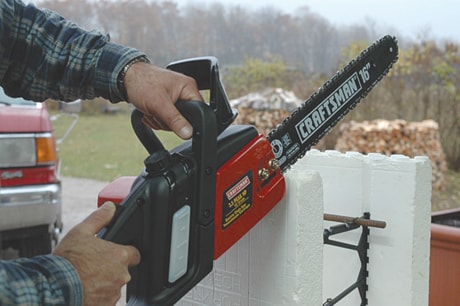Chainsaws are the fastest way to cut tree limbs, brush and wood of all kinds in landscaping situations, but the noise, expense and fuel involved in running a gas-powered model puts them out of the realm of what’s reasonable for many Canadian homeowners.
This is where electric chainsaws make sense.
Sure, electrics aren’t up to the job of felling big timber or making serious amounts of firewood, but there are surprisingly effective models out there for smaller applications. Though inexpensive, electric chainsaws, can save you a lot of money you’d otherwise have to spend hiring a landscaping service. They’re even a big help in certain building situations.
To get a better sense of the saws I’m talking about, I took apart a Craftsman 16 — inch model.
At $120, it’s cheap enough to justify for occasional use, and readily available across Canada.
It’s also a surprisingly good little saw, built better than you might expect. It delivers power roughly equivalent to a 30cc gas saw, which is more than enough for jobs around the yard, yet without the noise, fumes and hassles of keeping mixed gas on hand. Despite its mostly-plastic construction, the Craftsman does have proper ball bearings where it counts.
This saw is reminiscent of gas models in other ways, too. The chain is driven by a six-tooth sprocket that looks just like the ones on my gas chainsaws.
The only difference is that this sprocket isn’t connected to a centrifugal clutch.
Being electric, the tool doesn’t need one.
The chain simply stops and starts when the motor is turned ON and OFF with the finger trigger.
As makes sense with a saw meant for general consumer use, the Craftsman comes with an anti-kickback safety chain, and there are two reasons this matters.
The chain is that part of a chainsaw that spins around and does the cutting. It’s got teeth, and if those teeth catch onto the wood while cutting, the saw can jump back at you.
That’s definitely not good, and it’s the reason for anti-kickback saw chains. They include an extra protrusion of metal in front of each tooth that limits the bite of wood that the teeth can take.
This reduces the chance of kickback, though at a price. Anti-kickback chains cut roughly half as fast as conventional cutting chains.
The key to staying safe with any kind of chainsaw is to avoid letting the tip of the tool touch anything while you’re cutting.
This can cause kickback even with an anti-kickback chain. You also need to understand and anticipate how a tree branch or other object will move and potentially pinch the chainsaw as the cut nears completion.
Always work so the weight of the wood opens up the cut and moves the wood apart on each side of the saw chain while you work.
Although most people don’t bother, I also where a face shield, hearing protection and special safety chaps to protect my legs whenever I use a chainsaw.
Got some building to do? Electric chainsaws are often a pretty good way to complete cuts wider than what’s possible with other power saws.
They’re useful for notching out rafters, cutting insulated concrete forms and SIPs panels, for punching out door and window openings through sheathing, cutting engineered beams, rough demolition work, creating holes for roof vents, and crosscutting landscape timbers.
Whatever you do, don’t take electric chainsaws for granted.
They look like toys but they’re just as powerful as a plug-in circular saw, and they’ve got a lot more teeth whizzing around all out in the open.
Chainsaws really are the best tools for some tasks.
Decent electric models are also cheap and easy keepers, making them a pretty good bet if you’ve got a few trees and shrubs that need trimming now and then, or even some building and renovation jobs to deal with.
Steve Maxwell is Canada’s award-winning home improvement expert, and technical editor of Canadian Home Workshop magazine. Sign up for his free homeowner newsletter at www.stevemaxwell.ca
